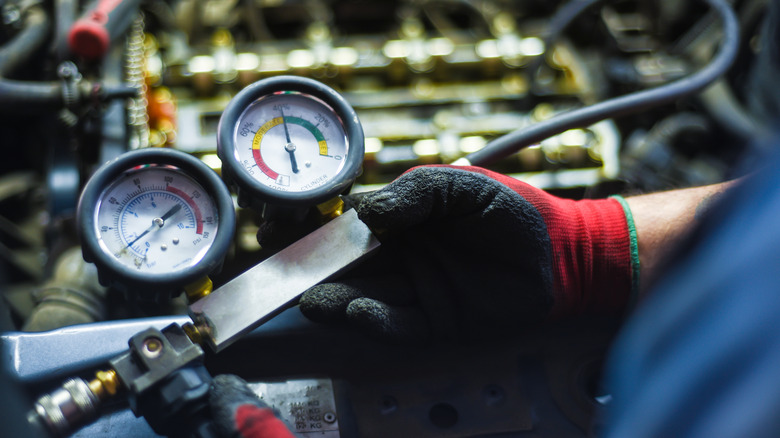What Does An Engine Compression Tester Do, And Do You Need One In Your Garage?
We may receive a commission on purchases made from links.
I have been working on my own vehicles for almost 40 years and in that time have accumulated a sizable collection of tools. The bulk of them are basic hand tools like sockets, wrenches, pliers, and the like, but in my many toolboxes and bags are a couple of power tools from Milwaukee as well as several made by Bosch, which placed fourth in our ranking of major power tool brands. I've even slummed it for some of my collection and bought a few auto repair tools from Harbor Freight, most of which have proven themselves to be surprisingly durable for the price.
While browsing auto repair and maintenance tools at your local parts store, you've likely come across compression testers like the Orion Motor Tech 8-piece kit, which Amazon sells for $16.99. The online retail giant also carries an OTC deluxe compression test kit with digital gauge that usually sells for $121.07. Compression test kits do just what they say: measure the ability of each cylinder of your engine to combust the fuel/air mixture without losing any of the resulting energy. While they're not as essential to a basic toolkit as a good torque wrench, a compression tester can help you troubleshoot engine problems, especially if you have an older or high-mileage car.
Disable the fuel system before testing compression
An engine compression test kit consists of a pressure gauge and an assortment of hoses and fittings so that the gauge can be connected to the spark plug holes on each of an engine's cylinders. To test an engine's compression, first label the spark plug wires according to the cylinder to which they are attached. Consult your owner's manual or factory service manual, or call your dealership's service department for the cylinder arrangement and firing order for your vehicle.
Warm the engine up to operating temperature by running it for a few minutes at idle. Next, disable your engine's fuel delivery system by removing the fuse or relay for the fuel pump so your engine doesn't start during the test. After the fuse or relay is pulled, run the engine until it stalls. Remove the plug wires and spark or glow plugs, and attach the correct fitting to the plug socket on cylinder No. 1.
Compression should be consistent across all the cylinders
Crank the engine for a few seconds, and note the pressure reading on the gauge. Reset the gauge, repeat the process for each of the remaining cylinders on your engine, and replace the spark plugs and wires and fuel pump fuse or relay. For gasoline engines, compression on all cylinders should be at least 100 pounds per square inch, and a healthy engine will return roughly equivalent readings of between 130 and 175 PSI for all cylinders.
A deviation of up to 5% reflects normal engine wear, but anything more than that could indicate a problem with a particular cylinder. If you have a diesel engine, you should expect to see readings between roughly 300 and 400 PSI. Diesel engines rely on this higher compression to ignite the fuel/air mixture, while gas engines use the spark from the plugs for ignition. If compression is low on one or more cylinders, it may be time for a new head gasket, valvetrain overhaul, or engine rebuild.


